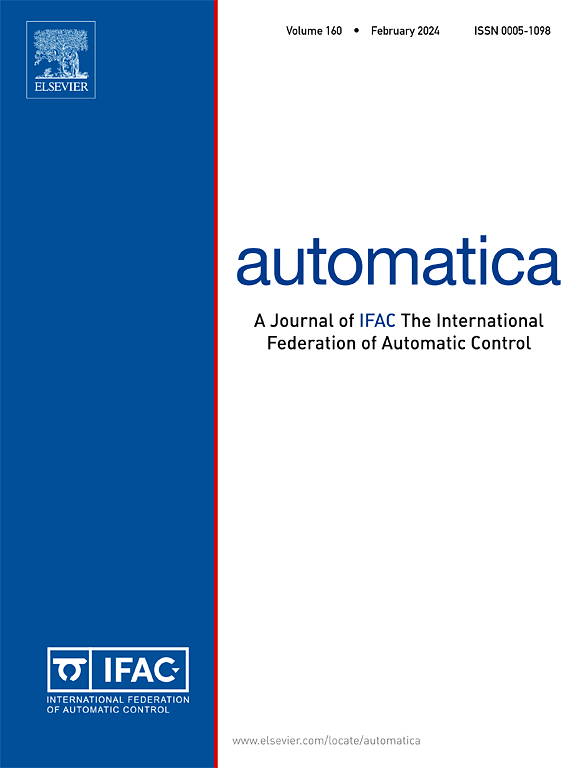Line zonotopes: A tool for state estimation and fault diagnosis of unbounded and descriptor systems
IF 5.9
2区 计算机科学
Q1 AUTOMATION & CONTROL SYSTEMS
引用次数: 0
Abstract
This paper proposes new methods for set-based state estimation and active fault diagnosis (AFD) of linear descriptor systems (LDS). Unlike intervals, ellipsoids, and zonotopes, constrained zonotopes (CZs) can directly incorporate linear static constraints on state variables – typical of descriptor systems – into their mathematical representation, leading to less conservative enclosures. However, for LDS that are unstable or not fully observable, a bounded representation cannot ensure a valid enclosure of the states over time. To address this limitation, we introduce line zonotopes, a new representation for unbounded sets that retains key properties of CZs, including polynomial time complexity reduction methods, while enabling the description of strips, hyperplanes, and the entire -dimensional Euclidean space. This extension not only generalizes the use of CZs to unbounded settings but can also enhance set-based estimation and AFD in both stable and unstable scenarios. Additionally, we extend the AFD method for LDS from Rego et al. (2020) to operate over reachable tubes rather than solely on the reachable set at the final time of the considered horizon. This reduces conservatism in input separation and enables more accurate fault diagnosis based on the entire output sequence. The advantages of the proposed methods over existing CZ-based approaches are demonstrated through numerical examples.
线共拓扑:无界和广义系统的状态估计和故障诊断工具
提出了基于集的线性广义系统状态估计和主动故障诊断的新方法。与区间、椭球体和带共拓扑不同,约束带共拓扑(cz)可以直接将状态变量(典型的描述系统)上的线性静态约束合并到它们的数学表示中,从而导致较少的保守封闭。然而,对于不稳定或不完全可观察的LDS,有界表示不能确保随着时间的推移有效地封闭状态。为了解决这一限制,我们引入了线分区,这是一种新的无界集表示,保留了cz的关键属性,包括多项式时间复杂度降低方法,同时能够描述条带,超平面和整个n维欧几里德空间。这个扩展不仅将cz的使用推广到无界设置,而且还可以在稳定和不稳定的场景中增强基于集的估计和AFD。此外,我们对Rego等人(2020)的LDS的AFD方法进行了扩展,使其可以在可到达的管道上操作,而不仅仅是在考虑视距的最后时间的可到达集上操作。这减少了输入分离的保守性,使基于整个输出序列的故障诊断更加准确。通过数值算例说明了所提方法相对于现有基于cz的方法的优越性。
本文章由计算机程序翻译,如有差异,请以英文原文为准。
求助全文
约1分钟内获得全文
求助全文
来源期刊

Automatica
工程技术-工程:电子与电气
CiteScore
10.70
自引率
7.80%
发文量
617
审稿时长
5 months
期刊介绍:
Automatica is a leading archival publication in the field of systems and control. The field encompasses today a broad set of areas and topics, and is thriving not only within itself but also in terms of its impact on other fields, such as communications, computers, biology, energy and economics. Since its inception in 1963, Automatica has kept abreast with the evolution of the field over the years, and has emerged as a leading publication driving the trends in the field.
After being founded in 1963, Automatica became a journal of the International Federation of Automatic Control (IFAC) in 1969. It features a characteristic blend of theoretical and applied papers of archival, lasting value, reporting cutting edge research results by authors across the globe. It features articles in distinct categories, including regular, brief and survey papers, technical communiqués, correspondence items, as well as reviews on published books of interest to the readership. It occasionally publishes special issues on emerging new topics or established mature topics of interest to a broad audience.
Automatica solicits original high-quality contributions in all the categories listed above, and in all areas of systems and control interpreted in a broad sense and evolving constantly. They may be submitted directly to a subject editor or to the Editor-in-Chief if not sure about the subject area. Editorial procedures in place assure careful, fair, and prompt handling of all submitted articles. Accepted papers appear in the journal in the shortest time feasible given production time constraints.
 求助内容:
求助内容: 应助结果提醒方式:
应助结果提醒方式:


